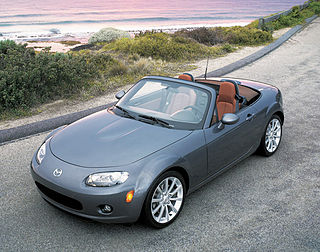
A convertible or cabriolet is a passenger car that can be driven with or without a roof in place. The methods of retracting and storing the roof vary between models. A convertible allows an open-air driving experience, with the ability to provide a roof when required. Potential drawbacks of convertibles are reduced structural rigidity and cargo space.

The North American International Auto Show (NAIAS) is an annual auto show held in Detroit, Michigan, U.S., at TCF Center. The show was held in January from 1989 to 2019. It was intended to move to the summer in 2020, but it has been suspended since due to the COVID-19 pandemic in the United States. It is among the largest auto shows in North America. UPI says the show is "regarded as the foremost venue for [car] manufacturers to unveil new products".

Wilhelm Karmann GmbH, commonly known as simply Karmann, was a German automobile manufacturer and contract manufacturer based in Osnabrück.
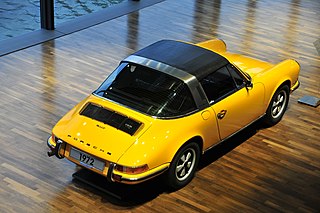
Targa top, or targa for short, is a semi-convertible car body style with a removable roof section and a full width roll bar behind the seats. The term was first used on the 1966 Porsche 911 Targa, and it remains a registered trademark of Porsche AG.

The Mercedes-Benz CLK-Class is a former series of mid-size or entry-level luxury coupés and convertibles produced by Mercedes-Benz between 1997 and 2010. Although its design and styling was derived from the E-Class, the mechanical underpinnings were based on the smaller C-Class, and was positioned between the Mercedes-Benz SLK-Class and CL-Class. It primarily competes with the BMW 3 Series Coupé and Audi A4 Cabriolet.

The BMW E36 is the third generation of the BMW 3 Series range of compact executive cars, and was produced by the German automaker BMW from 1990 to 2000. The initial models were of the four-door sedan body style, followed by the coupe, convertible, wagon ("Touring"), hatchback ("Compact") and the rare four-door convertible Baur TC4 in later years.

A sunroof is a movable panel that opens to uncover a window in an automobile roof, allowing light and fresh air to enter the passenger compartment. Sunroofs can be manually operated or motor driven, and are available in many shapes, sizes and styles. While the term sunroof is now used generically to describe any glass panel in the roof, the term "moonroof" was historically used to describe stationary glass panes rigidly mounted in the roof panel over the passenger compartment. A moonroof has a glass panel that is transparent and usually tinted. Previous terms include Sunshine Roof, Sliding Head and Sliding Roof.
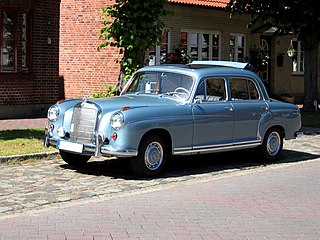
The Mercedes-Benz W128 is a 6-cylinder luxury car produced by Mercedes-Benz from 1958 to 1960 and marketed as the Mercedes-Benz 220 SE. It was available in sedan, coupé, or cabriolet body styles, and it was the last new model of the "Ponton" range which had design and styling roots beginning in 1953 with the Mercedes-Benz 180 sedan. It was largely identical to its 220 S predecessor, except for having petrol injection, 'Einspritzung' in German, reflected in the additional E in its 220 SE designation.

The Geneva International Motor Show is an annual auto show held in March in the Swiss city of Geneva. The show is hosted at the Palexpo, a convention centre located next to the Geneva Cointrin International Airport. The Salon is organised by the Organisation Internationale des Constructeurs d'Automobiles, and is considered an important major international auto show.

The Mercedes-Benz 124 series is a range of mid-size cars made by Daimler-Benz from 1984 to 1997. The range included numerous body configurations, and though collectively referred to as the W-124, official internal chassis designations varied by body style: saloon (W 124); estate (S 124); coupé (C 124); cabriolet (A 124); limousine (V 124); rolling chassis (F 124); and long-wheelbase rolling chassis (VF 124).

The Mercedes-Benz W111 was a chassis code given to a range of Mercedes-Benz vehicles produced between 1959 and 1971, including four-door saloons (1959-1968) and two-door coupés and cabriolets. Their bodywork featured distinctive tailfins that gave the models their Heckflosse nickname — German for "fintail".

The Audi Coupé was a liftback coupé version of the Audi 80, first shown in 1980. The bodywork was shared with the Audi Quattro. The second generation Coupé arrived in late 1988 and was based on the B3 Audi 80, albeit with a different suspension. The Coupé remained in production until the end of 1996 and spawned the Audi S2 series of sports versions. A convertible model arrived in 1991, called simply the Cabriolet, and remained in production until 2000.

The Mercedes-Benz W189 model 300 was a four-door luxury tourer produced by Mercedes-Benz between 1957 and 1962. It was the company's flagship model at the time, equivalent to the modern S-Class and Maybach.

The Mercedes-Benz W188 was a two-door luxury sports tourer produced by Mercedes-Benz between 1951 and 1958. The company's most expensive and exclusive automobiles, the elegant, hand-built 300 S (1951-1954) and its successor 300 Sc (1955-1958) were the pinnacle of the Mercedes line of their era.
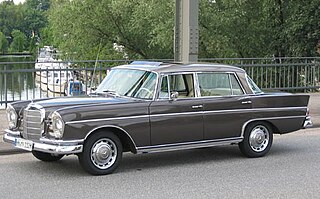
The Mercedes-Benz W112 is a luxury automobile produced by Mercedes-Benz from 1961 to 1967. Marketed as the 300SE, it was available as a coupé, convertible, sedan, and stretched sedan (Lang), all generally similar in appearance to the corresponding Mercedes-Benz W111.

The Mercedes-Benz W186 Model 300 was a four-door luxury sedan produced by Mercedes-Benz between 1951 and 1957. It was the company's flagship model at the time, succeeding the World War II era W150. Three versions were produced in succession, known informally as the 300a, 300b, and 300c. An enlarged "300d" variant built on the W189 chassis succeeded it in late 1957.

The Los Angeles Auto Show is an annual auto show held at the Los Angeles Convention Center in early December. The LA Auto Show is an OICA sanctioned international exhibition and also endorsed by the Greater Los Angeles New Car Dealers Association. It is open to the public for ten days each year, filling 760,000 square feet (71,000 m2) of exhibit space.
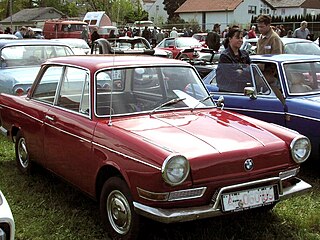
The BMW 700 is a small rear-engined car which was produced by BMW in various models from August 1959 to November 1965. It was the first BMW automobile with a monocoque structure. The 700 was a sales success at a time when BMW was close to financial ruin. The 700 was also successful in its class in motorsport, both in its stock form and as the basis of a racing special called the 700RS.

The automotive industry in Germany is one of the largest employers in the world, with a labor force of over 857,336 (2016) working in the industry.
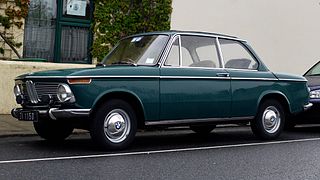
The BMW 02 Series is a range of compact executive cars produced by German automaker BMW between 1966 and 1977, based on a shortened version of the New Class Sedans.























